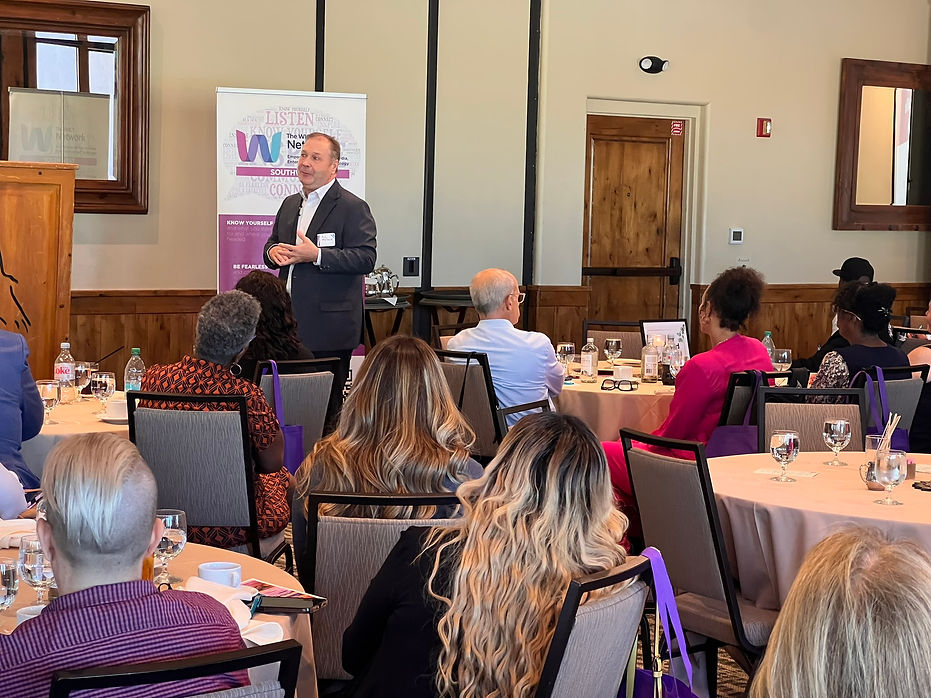

Breaking the Illusion: Leading Through Security and Innovation in the Age of AI
Insights from Gina Yacone, Richard Stallard and Clif Dawes
Held in a vibrant venue buzzing with energy, the event kicked off with refreshments, hors d’oeuvres, and group photos. Attendees mingled over networking bingo, sparking meaningful conversations and laughter as they customized name badges with fun identifiers like “Gamer,” “Outdoorsy,” and “Book Lover.”
Once everyone had connected, the room settled in to hear from three compelling speakers who shared transformative perspectives on leadership, security, and innovation in the AI era.
Breaking the Illusion of Security & Leading with Resilience
The first speaker opened with a sobering truth: “If bad actors want to come in, they will.” This prompted attendees to reconsider what true security looks like in an AI-powered world. Many organizations fall into “security theater”—implementing tools without fully enabling them or relying on partial MFA setups that leave vulnerabilities exposed. The illusion of progress, they warned, can be more dangerous than stagnation.
From the Breaking the Illusion deck, key insights included:
-
Efficiency vs. Resilience: Over-optimization can hinder adaptability. Efficiency equips you for today; resilience prepares you for tomorrow.
-
Small wins matter: Incremental progress builds trust and momentum.
-
Standardization unlocks capacity: It enables transformation and ongoing improvement.
-
Tools ≠ protection: Misconfigurations and weak IAM controls foster false confidence.
-
Clarity is critical: Oversimplified dashboards and filtered reports can obscure real threats
Call to Action:
-
Fortify your foundation
-
Communicate with precision
-
Foster open dialogue
-
Expand your perspective
-
Commit to ongoing evolution
Security isn’t a checklist—it’s a mindset. In the age of AI, that mindset must be rooted in transparency, adaptability, and human connection.
Innovation, Illusions & the Kodak vs. Intel Moment
The second speaker brought a strategic lens, cautioning that organizations are approaching a crossroads: a Kodak moment of missed innovation or an Intel moment of strategic reinvention. Many are chasing efficiency—cutting costs, reducing headcount—without considering the long-term impact on resilience and creativity.
Key takeaways included:
-
Standardize with intention to reduce complexity and unlock innovation.
-
Invest in people, not just platforms.
-
Avoid vague AI initiatives that leave IT scrambling.
-
Measure what matters—progress, not just compliance.
The message was clear: “Brilliance in the basics is key. Build a strong foundation before chasing shiny tech.”
Context, Security & the Human Edge in AI
The third speaker explored the nuances of generative AI and the critical role of human oversight. They introduced the three golden rules of generative AI:
Context. Context. Context.
Without it, AI falls short.
They explained the difference between lexical and semantic search:
-
Lexical matches exact words—simple but rigid.
-
Semantic understands meaning and intent—enabling natural, conversational AI.
As we enter a new era of instructional interaction, where AI tailors responses based on how we engage, the speaker issued a stark reminder:
“Anything you write online can be intercepted.”
A chilling example illustrated the risk:
“We are planning a market expansion and would like to find competitor offerings for the Southeast region of Duluth.”
Even a benign query can expose strategic intent. Your IP address, cookies, and LinkedIn profile can be triangulated to identify you—and your goals.
Security must evolve with AI.
Firewalls alone aren’t enough. Enterprise tools like Copilot have deep access—so strategy must lead, not reaction.
While AI can learn from vast datasets, it lacks:
-
Wisdom
-
Empathy
-
Moral reasoning
-
Accountability
AI doesn’t invent—it compiles. It doesn’t feel emotional impact. It doesn’t live with consequences. We do.
Closing message:
“AI is the engine, but humanity is the driver.”
To truly innovate, we must invest in human capabilities—creativity, judgment, emotional intelligence—and use AI as an assistant, not a replacement.
Finding Personal Success with AI
Beyond enterprise strategy, AI can be a powerful tool for personal productivity. To unlock its potential, ask yourself:
-
What drains my energy?
-
Am I stuck in too many meetings?
-
Do I have time for deep work?
-
Am I buried in emails?
-
What am I postponing due to busyness?
Use AI to reclaim your time—automate tasks, generate ideas, and simplify your day. Whether it’s summarizing emails, drafting content, or organizing your schedule, AI can help you refocus.
Author’s Aside:
Personally, I’ve found AI helpful beyond work. I use it to explore makeup shades, color palettes and outfit styles that suit me. It’s like having a stylist and creative consultant in my pocket.
Final Reflections: Humanity’s Role in an AI World
In closing, attendees were reminded of AI’s limitations and the enduring value of human insight. While AI is revolutionizing telecommunications—from chatbots to network optimization—it cannot replicate emotional depth, ethical reasoning, or intuitive wisdom.
Dawes emphasized that while AI can analyze sentiment and automate tasks, it cannot truly empathize, invent from scratch, or navigate moral complexity. Whether responding to a distressed customer or envisioning a disruptive new service, human creativity and emotional intelligence remain irreplaceable.
Key Callouts:
-
AI lacks general intelligence, common sense, and empathy.
-
Human creativity is fueled by emotion and abstract thought.
-
Ethical leadership requires moral reasoning, not just logic.
-
Strategic AI integration must be paired with:
-
Emotional intelligence
-
Ethical decision-making
-
Strategic foresight
-
Complex problem-solving
-
Authentic creativity
-
Takeaway: AI is the Engine—Humanity is the Driver
The future belongs to leaders who know when to lean on technology and when to lead with heart.
Final Thought: Evolve, Don’t Fear
We’re in a transformative storm. The rise of AI isn’t a threat—it’s an opportunity. But only if we lead with clarity, empathy, and strategy.
-
Build habits around AI
-
Free yourself for meaningful work
-
Expand your perspective
-
Encourage honest dialogue
-
Embrace mistakes—they’re part of growth
Because in the end, failure is just opportunity in disguise.



